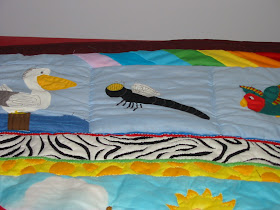Everyone who knows me knows I have a myriad of interests, and will have a go at just about anything. I started sewing properly back in 1990, and have dabbled ever since. I've no plans to make a career out of it, but I've already saved a lot by doing alterations and repairs. Here is some photos of the two quilts I've made, or helped make.
Gift 2004 - Noah's ark quilt 1330 x 1560mm in size
Central panel hand quilted by my wife - panel is one of the preprinted style available through the fabric stores.
Surrounding panels have a set of themes.
The two side sets (vertical set of 4 panels per side) are the land animals
The top set of panels (5 panels) are the animals of the air (birds and bugs)
The bottom set of panels (5 panels) are water animals.

The borders to the panels sets are made in the colours of the rainbow and orientated to form a circular pattern around the ark.
The corner panels also have a theme which commences in the low RH corner and is read in a clockwise direction.
Low Right Hand Corner - the rains commence and the waters start to rise
LLHC - the rains continue and the waters are significantly higher
ULHC - the dove brings back the olive sprig
URHC - the waters recede from off the face of the earth
All panels with the exception of the large central panel are made from machine based applique methods.
All fabric is poly cotton - pre-shrunk, and sewn with polyester threads.
The rain in the lower corner panels is over-sewn with a silver metallic thread for effect.
A sample of some panels are shown in the photographs

The panels were designed by downloading images from the internet of animals (I found colouring pages to be the best for size and line detail), or I simply drew the images myself. I then made the applique pieces, turned them, and sewed them in place to create the panel. Detail such as leaves, bubbles, etc were then added, and the panel completed.

The dove was particularly painful due to the colours of the rainbow.

I did a dragonfly, and used a chinzy tule to make it's wings so they retained their translucent effect... that was interesting to sew.

The quilt was made as a gift for my wife's best friend, and we both considered the effort we put into it time well spent for the recipient.
A quilt which I made for my beloved wife...
2006 - "Friends put a Bounce in your Heart" Winnie the pooh - 2100 x 2300mm in size
Started with a picture I downloaded from the internet which I blew up by clipping a sheet of builders plastic (orange translucent sheeting) to an overhead projector screen, and then opening the picture in a PC connected to a data projector.
Then it was simply a case of tracing the projected image onto the plastic and using that drawing for my cutting pattern.

Fabric was standard polycotton - preshrunk, sewn with polyester threads.
Style was normal machine applique.
At this stage the tracks of the bees and butterflies form the only quilting in the border panels.
The corner panels are each quilted with one letter of "POOH"

This quilt was made during a holiday where my wife left town to visit family, and I built my furnace - My better half was gone for about 8 days, and I would get up each day and work on the furnace from 7am until 2pm, then clean up and work on the quilt from 2pm until 11 pm. I think I threw in a couple of full days 7am-11pm) as well just to ensure this was done before she returned. It then sat in storage for a few months until it was given to her for a Christmas gift.
There is a panel stitched into the back with the title and dates of the quilt.
Equipment:
I have 2 sewing machines, and one overlocker - All I'm missing now is a table tennis table so I have a large foldup surface for laying out patterns and pinnings. Currently I use old doors on saw horses.
The sewing machines are nothing fancy - an old Elna air electronic I purchased secondhand, and a cheap Toyota which we bought when the Elna was looking like it was struggling repairing heavy fabric clothes (denims) - both machines have functioned flawlessly as long as we look after them.
I don't make quilts often - too much on "the list" as it is, but I'm often sewing at least once every month or two doing clothing repairs, or making some little doo-dad. Two weeks ago I made some ID card holders since the one I use at work fell apart and I blamed it on the poor design... let's see if my new design lasts longer than 3 months, then I can skite about it. My multimeter case worked well and has held up for quite a while now without concern.
This is how the kitchen table looked whilst I was making the panels for the Noah's ark quilt... another reason why I don't make quilts too often.

Many many thanks to those people who have taught me various sewing tricks over the years... Mostly Lyn for first teaching me how to use a sewing machine, then Rosemary for first teaching me how to use an overlocker, and Myjalessa for all the fancy tricks. I know I've missed others, but those three certainly started me off with this.












































